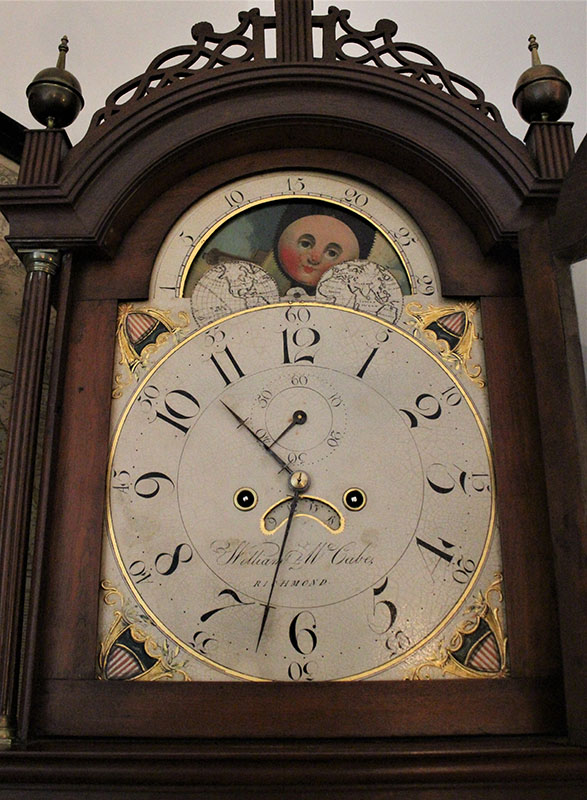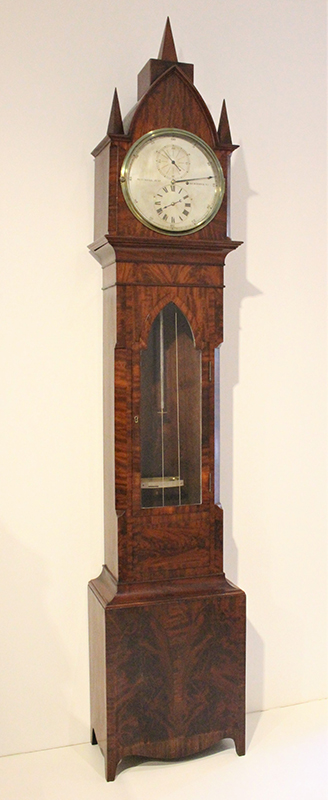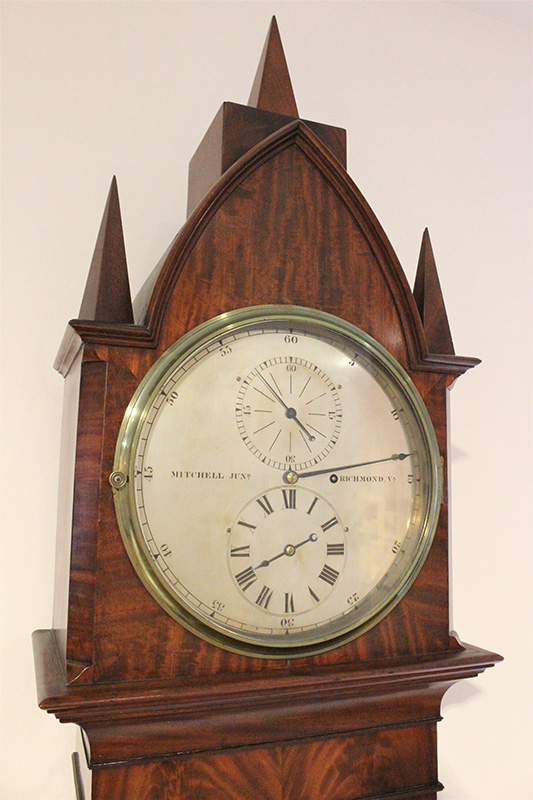“Watches and Clocks of Every Description”: Timepieces in Richmond, 1780–1860
by Rachel Asbury Cole
In 1780, Richmond was rapidly ticking towards becoming one of the South’s largest cities and a leader in both tobacco production and the domestic slave trade. Newly anointed as the capital of the Commonwealth, Richmond’s residents were growing more dependent on clocks for organizing daily life. Due to their expense, clock ownership had been quite limited until this point.1 Their acquisition still represented a significant level of prestige, but clocks increasingly became a tool of practical necessity.
At the Decorative Arts Trust’s Fall 2022 Symposium, I spoke about this topic in a lecture you can watch on the Trust’s YouTube channel.
Although a few trained clock and watchmakers settled in Virginia, a significant portion of their business focused on the repair and cleaning of clocks and watches rather than outright manufacturing. When crafting their own works, they often used a combination of imported and locally made parts.2 Clocks were also sourced through an agent or imported from England, France, or a major Northern city. Timepieces manufactured by the prodigious Willard family of Boston and Roxbury, MA, became particularly popular in Southern markets.3
In order to satisfy the public’s growing demand for timekeeping, the Willards began purposefully exporting their clocks to Southern retailers. In Richmond, this network included William McCabe, a clockmaker originally trained in Concord, MA. By 1804, McCabe was placing notices in Richmond newspapers advertising his ability to repair and warrant “Watches and Clocks of every description.”4 He also sold clocks, specifying he carried eight-day clocks and eight-day patent time pieces at his shop on Main Street under the sign of the large gold watch.
A clock that McCabe retailed now belongs to the Valentine Museum (figures 1 and 2). The dial bears his name, but closer examination reveals it was likely imported from the Willards or a craftsman previously trained in one of their shops. The mahogany and white pine case closely fits the stylistic standards of the Roxbury-style tall cases for which the Willards were known. Although McCabe advertised himself as a clockmaker, the unavoidable similarity to many documented Willard examples, coupled with their established practice of exporting clocks south, make it unlikely McCabe created this clock from scratch. Instead, he probably added his own name to a finished clock imported from New England.
McCabe’s inscription on the clock face was not meant to deceive customers, but was a practical reminder of the clock’s source. Weight-driven tall case movements required annual maintenance and cleaning. As the retailer and hopeful future repairman, McCabe placed his name where the clock’s owner would see it most frequently. Importing New England clocks, especially from a well-known shop like the Willards, likely proved to be a more lucrative business model than competing with works of his own manufacture.
A more direct example of this practice is that of William Mitchell Jr. The Museum of Early Southern Decorative Arts documented two tall case clocks that have Mitchell’s name painted across the dial and are accompanied by stamped or stenciled Willard labels on the interior of the case.5 Trained as a silversmith, Mitchell was active in Richmond from around 1816 to 1845, an era in which clocks were also sold in jeweler’s shops. Mitchell operated one of the largest in Virginia. Occasionally identifying as a watch and clockmaker, these clocks show he was selling imported timepieces.
The Valentine owns a third clock bearing Mitchell’s name (figures 3 and 4). The Gothic Revival mahogany and white pine case has long been attributed to an unknown Northern maker, but “Mitchell Junr./Richmond, Va” is engraved across the enormous silver-on-brass clockface. Recent research uncovered a strikingly similar example owned by the Willard House and Clock Museum manufactured by Simon Willard Jr., which features his name across the dial and carries a history of use in Willard’s Boston shop.
Both examples are regulators, timepieces by which clocks and watches are regulated. Frequently used in jeweler’s or watchmaker’s stores, regulators provided an extremely precise and accurate measurement of time by which to reset repaired clocks and watches. The provenance of the Valentine’s clock is unknown, but perhaps Mitchell fancied a regulator as a luxurious, impressive, and useful way to further align himself and his Richmond store with the most famous clock-making family in America.
Southern clock ownership continued to rise rapidly throughout the 19th century, despite the resistance to imported Northern goods. The addition of a retailer’s name to imported pieces became common practice. By 1860, on the eve of the Civil War, countless clocks ticked away in homes across Richmond, keeping time in a country more politically and economically divided than ever.
- Probate research conducted by Betty Crowe Leviner demonstrates only about one in four gentry level households in eastern Virginia owned a clock in the period from 1750 to 1775. Ronald L. Hurst and Jonathan Prown, Southern Furniture 1680–1830: The Colonial Williamsburg Collection (Williamsburg, VA: The Colonial Williamsburg Foundation, 1997): 541.
- This pattern is especially evident in the work of Thomas Walker of Fredericksburg and various makers throughout the Shenandoah Valley. Tara Gleason Chicirda, “Keeping Time: Southern Tall Case Clocks,” Antiques & Fine Art Magazine, Autumn/Winter 2012, 166–174.
- Gary Sullivan, “Clocks for Corn: Yankee Clockmakers Trading with the South” (lecture, Winterthur Furniture Forum, 2012).
- Virginia Argus, Volume 20, Number 2054, February 11, 1813.
- See MESDA Object Database NN-1631 and S-5922.
Rachel Asbury Cole is the Collections Project Manager/Registrar at the Valentine Museum.
A print version of this article was published in The Magazine of the Decorative Arts Trust, one of our most popular member benefits. Join today!




